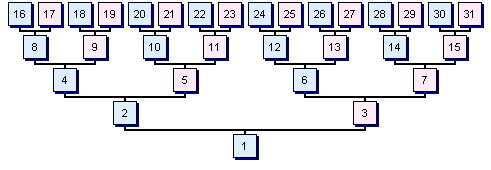Numbering
(Source : guide-généalogie.com)
Sosa-Stradonitz ascending numbering
It is essential to give your ancestors a number so that you can find your way around.
There are several numbering systems, depending on whether you are working in ascending or descending genealogy.
In ascending genealogy, you generally start with yourself.
In descending genealogy, you start with an ancestor, in order to find all his descendants.
This system was invented by the German Michel Eyzinger in 1590, followed by Jérôme de Sosa in 1676 and Kerule von Stradonitz in the 19th century.
His numbering system is the most practical and widely used for establishing an ascending genealogy.
Principles of sosa numbering
- Each ancestor has an invariable number.
- The numbering starts with the person whose ancestry is being traced, the de-cujus (glossary), who bears the number 1.
- His father is number 2 and his mother number 3.
- Number 4 is his paternal grandfather, number 5 his paternal grandmother, number 6 his maternal grandfather and number 7 his maternal grandmother.
- And so on…
Rules for sosa numbering
- An even number always refers to a man, an odd number to a woman, except of course for number 1, which is either a man or a woman.
- A father's number is double that of his child.
- A wife's number is her husband's number plus 1.
- A mother's number is double that of her child plus one.
Notes on sosa numbering
- The first number of a generation gives the number of ancestors in that generation. For example, the number 16 indicates that there are 16 ancestors in the 5th generation.
- The same ancestor may appear several times in the genealogy: this is called an implex (glossary). In this case, the ancestor has several sosa numbers.
- The sosa number established is only valid for an individual. For children or grandchildren, the numbering has to be redone.
- This system only takes direct ascendants into account. Collateral relatives do not have a number.

D'Aboville descending numbering
The principle of this numbering system :
- Numbering starts with an ancestor common to several individuals.
- The common ancestor is numbered 1.
- The descendant has the number of his or her father or mother, plus his or her birth order number.
- Thus, the eldest child of the common ancestor is 1.1, the second 1.2.
- The eldest's children have 1.1.1, 1.1.2…
When children come from different beds, we add one letter of the alphabet per bed: a for the first, b for the second... We immediately identify the child's mother.
If we count the number of numbers, we immediately know the number of generations. For example, 1.1.2 descends to the 3rd generation of the common ancestor.
Pélissier descending numbering
The principle is the same as for d'Aboville numbering, but the digits are replaced by letters. Capital letters are reserved for men.
The eldest child bears the letter A, the second child bears the letter B... The eldest child bears the following letters: AA for the eldest child if it's a boy, Ab for the second child if it's a girl.

 FR
FR IT
IT GB
GB